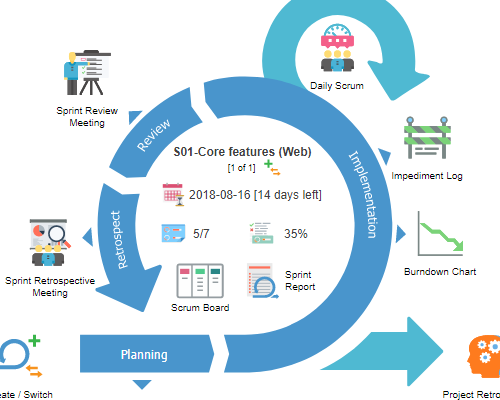In today’s fast-paced and ever-changing business landscape, organizations need to be able to adapt quickly to stay ahead of the competition. One way to achieve this is by using Agile project management methodologies, such as Scrum. In this article, we’ll take a closer look at what Scrum is, its benefits, and how it can help your organization deliver projects more efficiently and effectively.
What is Scrum?

Scrum is a framework for managing and completing complex projects using iterative and incremental practices. It emphasizes teamwork, accountability, and iterative progress toward well-defined goals. Scrum is a type of Agile methodology, which is a broader approach to project management that emphasizes flexibility, collaboration, and continuous improvement.
The Scrum Framework
The Scrum framework consists of three roles, three ceremonies, and three artifacts.
- Roles:
- Product Owner: responsible for defining and prioritizing the product backlog, which is the list of features or requirements for the project.
- Scrum Master: responsible for facilitating the Scrum process and ensuring that the team is following the framework.
- Development Team: responsible for developing the product or delivering the project.
- Ceremonies:
- Sprint Planning: a meeting where the team plans the work to be done during the upcoming sprint.
- Daily Scrum: a daily meeting where the team discusses progress, plans, and any obstacles.
- Sprint Review: a meeting where the team reviews the work completed during the sprint and receives feedback from stakeholders.
- Artifacts:
- Product Backlog: the list of features or requirements for the project.
- Sprint Backlog: the list of tasks to be completed during the sprint.
- Increment: the working product or deliverable at the end of the sprint.
How Scrum Works
Here’s a high-level overview of how Scrum works:
- The Product Owner creates and prioritizes the product backlog.
- The team holds a Sprint Planning meeting to plan the work to be done during the upcoming sprint.
- The team works on the tasks in the sprint backlog during the sprint.
- The team holds a Daily Scrum meeting to discuss progress, plans, and any obstacles.
- At the end of the sprint, the team holds a Sprint Review meeting to review the work completed and receive feedback from stakeholders.
- The team uses the feedback to improve the product and process during the next sprint.
Benefits of Scrum
Scrum offers many benefits, including:
- Improved collaboration: Scrum encourages teamwork and collaboration among team members.
- Increased transparency: Scrum provides a clear understanding of the project’s progress and goals.
- Faster time-to-market: Scrum’s iterative approach allows for faster delivery of working software.
- Improved quality: Scrum’s focus on testing and feedback ensures that the product meets the required quality standards.
- Greater flexibility: Scrum’s iterative approach allows for changes in requirements and priorities.
Getting Started with Scrum
If you’re interested in implementing Scrum in your organization, here are some steps to get started:
- Learn about Scrum: Read books, articles, and online resources to learn about Scrum and its framework.
- Identify a Scrum Master: Appoint a Scrum Master to facilitate the Scrum process.
- Create a product backlog: Create a list of features or requirements for the project.
- Plan the first sprint: Hold a Sprint Planning meeting to plan the work to be done during the first sprint.
- Start the sprint: Begin the sprint and follow the Scrum framework.
Conclusion
Scrum is a powerful framework for managing and completing complex projects. Its iterative and incremental approach allows for faster delivery of working software, improved collaboration, and greater flexibility. By following the Scrum framework and its roles, ceremonies, and artifacts, teams can deliver projects more efficiently and effectively. Whether you’re a seasoned project manager or just starting out, Scrum is definitely worth considering for your next project.
References
- Tutorials and Guides
- Scrum Process Canvas
- Scrum Tool and Resources
- Agile vs. Scrum
This rewritten list provides a more organized structure, grouping related resources and making it easier to find specific information about Scrum using Visual Paradigm.